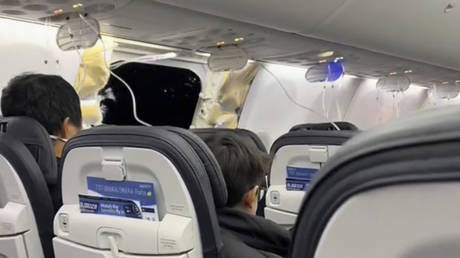ARTICLE AD BOX
United Airlines has revealed that inspections following a rival’s midair blowout found that door plugs weren’t properly secured
United Airlines has discovered inadequately secured door plugs on the Boeing 737 MAX 9 planes that it grounded in the wake of last week’s midair blowout on an Alaska Airlines flight, raising new safety concerns about an aircraft that was previously suspended from flying following two deadly crashes.
“Since we began preliminary inspections on Saturday, we have found instances that appear to relate to installation issues in the door plug -- for example, bolts that needed additional tightening,” United said in a statement. “These findings will be remedied by our Tech Ops team to safely return the aircraft to service.”
The US Federal Aviation Administration (FAA) ordered the grounding of all 737 MAX 9 airliners for safety checks after a door plug blew out in midair during an Alaska Airlines flight on Friday. The crew was forced to turn back and make an emergency landing in Portland, Oregon, where the flight originated, and several of the 171 passengers suffered injuries.
Read more Scores of Boeings grounded worldwide after midair blowout incident
Scores of Boeings grounded worldwide after midair blowout incident
The FAA decision affected an estimated 171 planes and led to the cancellations of hundreds of flights. United said it has 79 Boeing 737 MAX 9s in its fleet. The airline didn’t disclose how many of its jets had loose bolts. Alaska Airlines has 65 MAX 9s.
The FAA said all MAX 9s will remain grounded until operators complete enhanced inspections and take any needed corrective actions. “The FAA’s priority is always keeping Americans safe,” the agency added.
A separate agency, the National Transportation Safety Board (NTSB), is investigating the midair blowout. The door plug, which blew out at an altitude around 16,000 feet, was found by a Portland schoolteacher in his backyard.
Alaska Airlines had previously stopped using the plane that suffered the blowout on trips to Hawaii because a warning light indicating a possible pressurization problem had lit up on several previous flights, NTSB chairwoman Jennifer Homendy told reporters on Sunday. The aircraft was restricted to shorter flights over land so it could “return very quickly to an airport” if the warning light lit up again, she said. However, she added, the NTSB hasn’t yet confirmed a connection between the previous pressurization warnings and Friday’s blowout.
READ MORE: Boeing wants safety waiver for latest 737 MAX
Aviation regulators around the world banned the 737 MAX, Boeing’s top-selling airliner, in March 2019, after crashes in Indonesia and Ethiopia killed a combined 346 people. The aircraft was cleared to resume flying again in the US and most other major markets about two years later, following repairs to a flight control system that was blamed for the crashes.
New safety concerns surfaced last month, when Boeing urged 737 MAX operators to inspect their planes for a possible loose bolt in the rudder control system. The warning came after an unidentified airline found a rudder bolt with a missing nut during routine maintenance work.
.png)
 1 year ago
3
1 year ago
3








 English (US)
English (US)